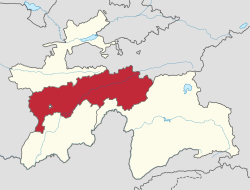Districts under Central Government Jurisdiction
Districts under Central Government Jurisdiction
ناحیه های تابع جمهوری | |
|---|---|
 Districts under Central Government Jurisdiction in Tajikistan | |
| Coordinates: 39°0′N 70°0′E / 39.000°N 70.000°ECoordinates: 39°0′N 70°0′E / 39.000°N 70.000°E | |
| Country | |
| Capital | Dushanbe |
| Area | |
| • Total | 28,500 km2 (11,000 sq mi) |
| Population (2020) | |
| • Total | 2,165,900 |
| • Density | 76/km2 (200/sq mi) |
| ISO 3166 code | TJ-RA |
| HDI (2017) | 0.641[1] medium |
| Official languages | |
| Wikimedia Commons has media related to Region of Republican Subordination. |
Districts under Central Government Jurisdiction (Russian: Районы республиканского подчинения, romanized: Rajony respublikanskogo podchineniya; Tajik: Ноҳияҳои тобеи ҷумҳурӣ, romanized: Nohiyahoyi tobe'i jumhurî Latin Tajik alphabet: Tajik: Nohijahoji toвe’i çumhurī) is a region in Tajikistan, consisting of 9 districts and 4 district-level cities that are directly under central administration.[3] Dushanbe, the capital of Tajikistan, is surrounded by the Districts under Central Government Jurisdiction, but not part of it. The region covers an area of 28,500 square kilometres, and has a total population of 2,165,900 (2020),[3] The Districts' ethnic composition in 2010 was 85% Tajik and 11.7% Uzbek.[4]
History[]
The Districts under Central Government Jurisdiction cover much of the territory of the former Gharm Oblast which was dissolved in 1955. They were formerly known as Karotegin Region.
Administrative divisions[]
The Districts under Central Government Jurisdiction cover 9 districts and 4 district-level cities: Vahdat, Tursunzoda, Hisor and Roghun. The districts are:[3]
- Fayzobod District
- Lakhsh District (formerly Jirgatol District)
- Nurobod District (formerly Darband District)
- Rasht District (formerly Gharm District)
- Rudaki District (formerly Leninskiy District)
- Sangvor District (formerly Tavildara District)
- Shahrinav District
- Tojikobod District
- Varzob District
Geography[]
The plateau is traversed by the river Vakhsh, a right-hand tributary of the Amu Darya. On the northern border run the Gissar and Zeravshan mountains, and on the southern border the Darvaz range 7,600 metres (24,900 ft). The winter climate is extremely severe: snow begins to fall in October and it is May before it disappears. During the warmer months, however, the mountainsides are richly clothed with the foliage of maple, mountain ash, apple, pear and walnut trees; the orchards furnish not only apples and pears, but peaches, cherries, mulberries and apricots. Both cattle and horses are of a small and hardy breed.[5]
References[]
- ^ "Sub-national HDI - Area Database - Global Data Lab". hdi.globaldatalab.org. Retrieved 2018-09-13.
- ^ "КОНСТИТУЦИЯ РЕСПУБЛИКИ ТАДЖИКИСТАН". prokuratura.tj. Parliament of Tajikistan. Retrieved 9 January 2020.
- ^ a b c "Population of the Republic of Tajikistan as of 1 January 2020" (PDF) (in Russian). Statistics office of Tajikistan. Retrieved 12 October 2020.
- ^ "CensusInfo - Data". www.censusinfo.tj. Retrieved 2019-09-09.
- ^ One or more of the preceding sentences incorporates text from a publication now in the public domain: Chisholm, Hugh, ed. (1911). "Karateghin". Encyclopædia Britannica. 15 (11th ed.). Cambridge University Press. p. 677.
- Districts of Republican Subordination
- Subdivisions of Tajikistan
